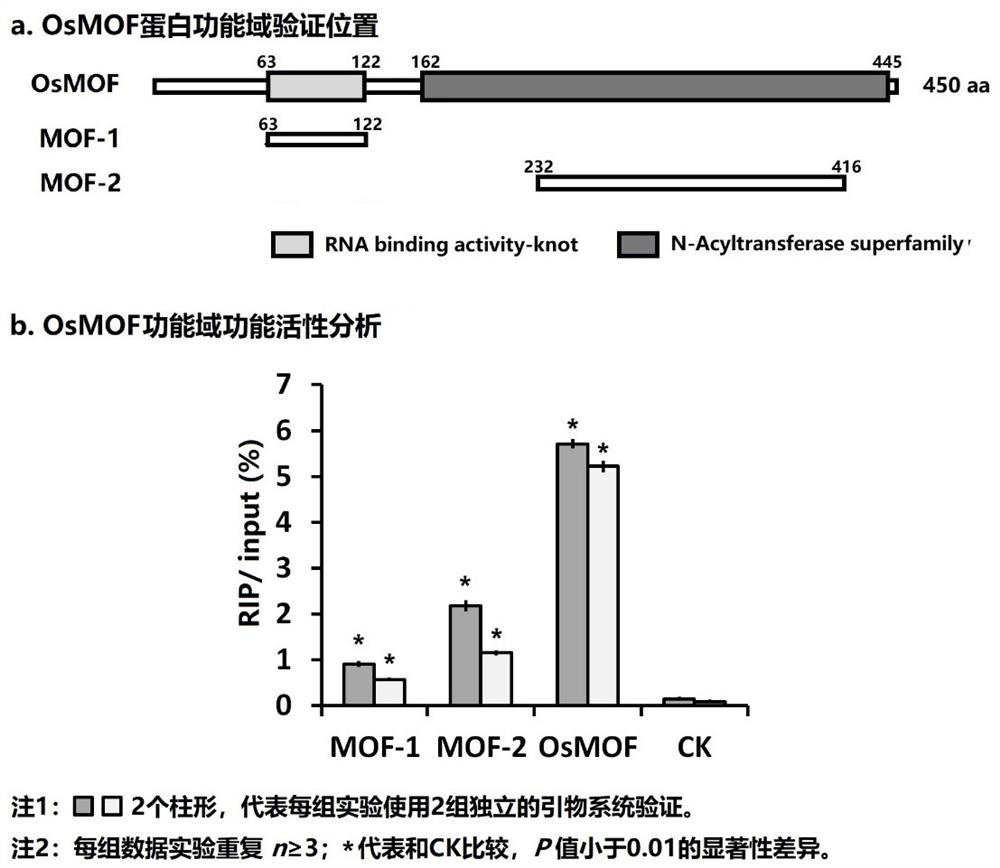Application of epigenetic modification OsMOF protein in improvement of rice yield traits
A protein and rice technology, applied in the fields of application, plant genetic improvement, plant products, etc., can solve the problems of unidentified members of apparent modification proteins and backward research
- Summary
- Abstract
- Description
- Claims
- Application Information
AI Technical Summary
Problems solved by technology
Method used
Image
Examples
Embodiment 1
[0052] Example 1. Construction OSMO gene expression vector
[0053] (1) OSMO Gene and Protein Structural Composition
[0054] rice OSMO Gene, NCBI database Gene ID: 4343971. The gene is located on rice chromosome 7, with a total length of 4891bp in the transcribed region of the genome, NCBI number NC_029262.1, with 9 exons and 8 introns, and the transcription structure diagram is as follows figure 1 shown. The transcribed sequence is numbered XM_015789227.2 by NCBI. The full length of the sequence is 1655bp, and the full length of the coding region is 1353bp. The sequence is shown in SEQ ID NO.1. The gene encodes 450 amino acids, the OsMOF protein sequence NCBI number XP_015644713.1, and the amino acid sequence is shown in SEQ ID NO.2. The rice OsMOF protein contains 1 RNA binding activity-knot (RNA binding activity) functional domain and 1 N-Acyltransferase superfamily (acetyltransferase activity) functional domain. The structure of the protein functional domain is sho...
Embodiment 2
[0072] Example 2. OSMO Gene domain activity analysis
[0073] rice OSMO The sequence of two functional domains of the gene, RNA binding activity-knot (RNA binding activity) functional domain and N-Acyltransferase superfamily (acetyltransferase activity) functional domain:
[0074] SEQ ID NO.5: Rice OSMO Gene-encoded protein RNA binding activity-knot (RNA binding activity) functional domain amino acid sequence (60aa)
[0075] LEVGTRVMCRWRDQKLHPVKVIERRKSSTSSSPADYEYYVHYTEFNRRLDEWVKLEQLDL.
[0076] SEQ ID NO.6: Rice OSMO Amino acid sequence of functional domain of gene-encoded protein N-Acyltransferase superfamily (acetyltransferase activity) (284aa)
[0077] LDAASLREHEEFTKVKNIAKIELGRYEIDTWYFSPFPPEYNDSPKLFFCEFCLNFMKRKEQLQRHMKKCDLKHPPGDEIYRSGTLSMFEVDGKKNKVYGQNLCYLAKLFLDHKTLYYDVDLFLFYVLCECDDRGCHMVGYFSKEKHSEESYNLACILTLPPYQRKGYGKFLIAFSYELSKKEGKVGTPERPLSDLGLLSYRGYWTRVLLEILKKHKSNISIKELSDMTAIKADDILSTLQSLDLIQYRKGQHVICADPKVLDRHLKAAGRGGLEVDVSKLIWTP。
[0078] rice OSMO The two functio...
Embodiment 3
[0080] Example 3. OSMO Transformation of rice receptor with gene expression vector
[0081] The rice material is the indica variety Minghui 63, and the transformation recipient material is the callus induced by mature embryos of this variety. The plant medium used in the transformation process is MS basic medium. The main components and formula are shown in Table 1. The transformation method is an Agrobacterium transformation method, the Agrobacterium tumefaciens strain is Agrobacterium tumefaciens LBA4404, and the microbial culture medium used for cultivating the Agrobacterium in the transformation process is a YEP medium.
[0082] Table 1. Plant media for rice transformation
[0083]
[0084] Note: *The above media all contain 30g / L sucrose + 2.5g / L plant agar.
[0085] (1) Rice callus induction
[0086] ① Remove the hulls from the seeds of the mature rice indica variety Minghui 63.
[0087] ② Under aseptic conditions, soak with 70% ethanol for 5 minutes and wash with...
PUM
 Login to View More
Login to View More Abstract
Description
Claims
Application Information
 Login to View More
Login to View More - R&D Engineer
- R&D Manager
- IP Professional
- Industry Leading Data Capabilities
- Powerful AI technology
- Patent DNA Extraction
Browse by: Latest US Patents, China's latest patents, Technical Efficacy Thesaurus, Application Domain, Technology Topic, Popular Technical Reports.
© 2024 PatSnap. All rights reserved.Legal|Privacy policy|Modern Slavery Act Transparency Statement|Sitemap|About US| Contact US: help@patsnap.com










